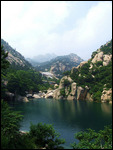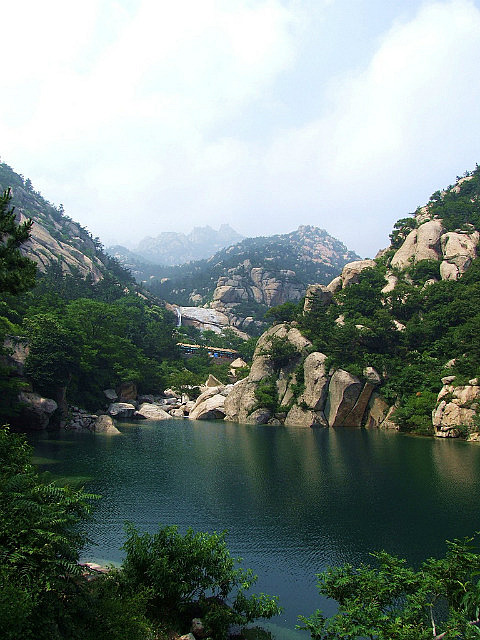I've never visited Qingdao or Shandong Province for that matter, but I've heard some neat things about it. The city of Qingdao started out as a colonial town for the Germans before WWI, and grew into a major port city of northern China. Techniques for brewing beer was first introduced to China here, and the result is the most popular beer brand in the world - Tsingtao beer. The surrounding area of Shandong Province - the Shandong Peninsula - has always been defined by its long rugged coastline. Taoist myths abound here, from the Eight Immortals Crossing the Sea, to the fable of the Taoist Monk of Laoshan, to the supposed paradise islands off shore. The first emperor of China went there to seek drugs of immortality. Shandong province is also known for beautiful women (such as Gong Li, a famous actress), and muscular men.
We took a fast, commuter-type train from Beijing to Qingdao which would take 6 hours, in the same type of modern aerodynamic train cars that are used on the new high-speed rail networks in China. Near the end of the journey at around 9 pm, we were told the train would be 40 minutes late due to bad weather. Bad weather indeed as we walked out of the station and had to find a cab to the hotel. It was a torrential downpour that caused several inches of water to accumulate on the ground everywhere. Passing cab drivers would not take us because the distance to our hotel was too short and they didn't want their seats wet! Once we got to the hotel we were further treated with bad attitudes and poor service. It being the first place where I didn't have relatives living there, our attempt to travel independently got a lousy start.
The next morning we headed out to explore the beaches that make Qingdao the premier beach resort in northern China. Compared to elsewhere in the world however, the beaches were unspectacular, but for China which probably ranks among the world's lowest in per capita beach area they're not bad. With the weather hot and steamy many people were roaming the beaches, angling, beach combing, swimming, sun-bathing, playing volleyball, lounging in tents, and of course eating and drinking. Adjacent to the beaches in the old town are old neighborhoods with elegant European style mansions and villas, although most were not well-restored and had lost much of the charm to tacky modifications. One of the old German mansions (Huashilou) had been occupied by important Chinese politicians in the past, it is now a museum which luckily has retained much of its former character. Taking a taxi to the old downtown area, we ate lunch at a restaurant specializing in cuisine of Shandong Province listed in several tour guidebooks, and found the food quite good. Then we took a walk through the old town, visiting a catholic church, a protestant church, both of which were well-preserved but had no signs of worship activities. Art students sat around the churches to paint them in water-color. We took in the view from the peaceful Guanhaishan Park, on the top of a little hill close to the old downtown area, where lively locals played cards and argued loudly.
The next day we went to Mt Laoshan, about 40 km from town to the east. A mountain associated with Taoist mysticism, whose spring water is used for brewing Tsingtao beer, Mt Laoshan's majestic granite crags rise steeply from the sea. Because Mt Laoshan covers a large area with many destinations far from each other, the logistics used to be difficult if one doesn't want to hire a taxi for the day but still wants to visit several destinations. Now the system is straight forward - visitors only need to purchase a day pass which allows them to take any bus within the Mt. Laoshan Scenic Area. We chose to do a hike in the Taiqing Palace area, taking a cable car up then hike down to Dragon Pool waterfall, avoiding most of the strenuous uphill hike. Many independent local tour guides tried in vain to get our business. Through these conversations we figured out that the Dragon Pool waterfall actually has water at this time, despite many tour guides who said otherwise to sway us to visit other destinations. Taking this independent tour route gives us more time hiking in nature, it also means we would avoid being bussed around to several other destinations like many domestic tourists, which maximizes commissions for the tour guides.
The Mt Laoshan hiking trails had many vendors setting up shop along the route selling souvenirs, local green tea (real or fake), refreshments, and food. Most notable items on sale were toys for performing magic tricks, as well as fortune-tellers, both of which resonates with Mt. Laoshan's mystical appeal (after years of study the famous Monk of Mt Laoshan supposedly could walk through walls). We also saw sedan chairs each carried by two hardy guys hauling guests up hill. Huge granite cliffs and boulders were everywhere, the lush subtropical forests and clear bubbling streams were inviting, but cleanliness of areas along trails left something to be desired. We first hiked up to the Yunxia Cave Taoist monastery, where there were great views from the terrace to the mountain valley strewn with granite cliffs, and where 400 year-old trees coexisted with brand-new worship halls built in the tranditional style. The Taoist deities look distinctly Chinese unlike Buddhist deities, in the same vein Taoist monks still wear gable-shaped hats to cover their long hair and grow full beards like ancient hermits. We then descended the next valley to a larger Taoist monastery - Shangqing Palace, where monks live in buildings built in between huge granite boulders. Now we saw some blue sky in-between swirling mists! This was the first time we saw blue sky in China. From there we descended to Dragon Pool Waterfall, a spectacular gush of water off tall granite cliffs like a Yosemite waterfall. The pool below the waterfall was pristine but that's due to access being cut off from the tourist trail by walls, permitting viewing only for the hordes of people snapping photographs there. Descending from the fall we got to Dragon Pool Reservoir, a large crisp blue lake soaking the feet of giant granite cliffs, whose pristine shores were unapproachable from the tourist trail. Without all these tourists, this place could be an idyllic spot.
We took a short bus ride to Taiqing Palace, the largest Taoist monastery in the area, with spectacular manicured grounds. This is one of the oldest and most important Taoist monasteries in China. Curiously we saw several luxury cars parked in a private area, apparently belonging to the monks or the monastery. Exotic subtropical shrubs were neatly arranged to give a sense of reverence of nature, while monks in ancient garb performed chanting meditation at one of the upper halls. Many new buildings in the traditional style have been erected on the grounds with connecting galleries, bridges, walkways, and pavilions, all made out of local granite, making this a major tourist destination. Nice views of the distant coastline can be had, as well as babbling brooks, meditation caves, and many worship halls dedicated to different deities who protect and help the faithful in different ways. With a religion that seeks to give people pleasure, the monastery is a beautiful and happy place, not the kind that inspires soul-searching.
When we returned to Qingdao in the evening we went to the new center of town with many glitzy high-rises. Tired of eating Chinese food for many days straight, we ate western dinner at a Pizza Hut restaurant which in China is an upscale establishment with a full menu. The next day we had a half-day in Qingdao, so we explored the area of the old town near the train station. The station was built by Germans and has a sturdy and elegant air, with huge granite wall panels, classical arch doorways, and ornate chandeliers. Walking along the beach promenade in the old downtown, it is clear to us Qingdao has beautiful bones yet it has not fully capitalized on its great endowment of coastal scenery and architectural heritage.

